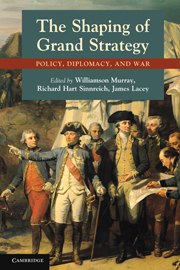Book contents
- Frontmatter
- Contents
- Contributors
- 1 Thoughts on grand strategy
- 2 The grand strategy of the grand siècle: Learning from the wars of Louis XIV
- 3 Strategic culture and the Seven Years' War
- 4 Strategy as character: Bismarck and the Prusso-German question, 1862–1878
- 5 About turn: British strategic transformation from Salisbury to Grey
- 6 British grand strategy, 1933–1942
- 7 Toward a strategy: Creating an American strategy for global war, 1940–1943
- 8 Harry S. Truman and the forming of American grand strategy in the Cold War, 1945–1953
- 9 Patterns of grand strategy
- Index
5 - About turn: British strategic transformation from Salisbury to Grey
Published online by Cambridge University Press: 05 June 2012
- Frontmatter
- Contents
- Contributors
- 1 Thoughts on grand strategy
- 2 The grand strategy of the grand siècle: Learning from the wars of Louis XIV
- 3 Strategic culture and the Seven Years' War
- 4 Strategy as character: Bismarck and the Prusso-German question, 1862–1878
- 5 About turn: British strategic transformation from Salisbury to Grey
- 6 British grand strategy, 1933–1942
- 7 Toward a strategy: Creating an American strategy for global war, 1940–1943
- 8 Harry S. Truman and the forming of American grand strategy in the Cold War, 1945–1953
- 9 Patterns of grand strategy
- Index
Summary
On a crisp morning in December 1905, a British general by the name of James Grierson and a French major by the name of Victor Huguet had what both later claimed was a chance encounter while horseback riding in London's Hyde Park. Grierson, however, happened to be the British War Office's director of operations and a passionate Francophile, while Huguet happened to be the French military attaché in London. Whether accidental or not, that encounter was followed by another less accidental meeting the following day, and a few weeks later by the inauguration of informal but officially sanctioned Anglo-French “staff conversations” that would continue off and on until the outbreak of World War I in August 1914.
Those conversations, and their contribution to Britain's subsequent decision to participate in a great power conflict on the European continent for the first time since the defeat of Napoleon a century earlier, continue to fascinate diplomatic and military historians. Most agree that, whatever their direct impact on that decision, the conversations themselves reflected a fundamental transformation of British foreign policy, the culmination of more than a decade of mounting concern about the British Empire's continued security and prosperity and the strategic arrangements needed to sustain them.
- Type
- Chapter
- Information
- The Shaping of Grand StrategyPolicy, Diplomacy, and War, pp. 111 - 146Publisher: Cambridge University PressPrint publication year: 2011



